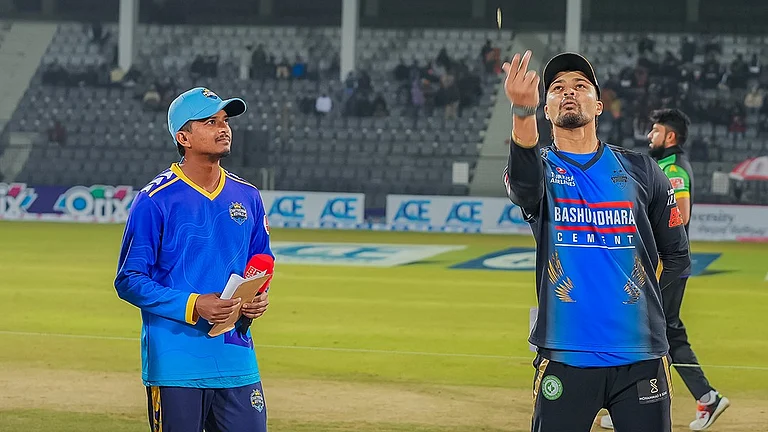How does one assess the greatness of one of the greatest auteurs in world cinema? I guess it is simpler to go from the particular to the general than try to deal with it as a whole. In Satyajit Ray’s Pather Panchali (Song of the Little Road, 1955), two children — Apu and his sister Durga — are running through the Kash field, the plants gently swaying in the wind, towards a passing train. Though they are fully integrated with the idyllic rural landscape, their attraction for the future, the modern, is unmistakable. The opposite pulls of an idealised, rural past and that of the obvious merits of a modern, scientific sensibility, in the mind of the city-dwelling auteur, form an essential aspect of Satyajit Ray’s early films though, arguably, not so much in the three novels by Bibhutibhushan Bandopadhyay from which they have been adapted.
This ambivalence permeates the Apu trilogy although the protagonist Apu is not a fully realised ‘Tagorean’ hero of the later films. Unlike them, he is not caught in a moral dilemma, between tradition and modernity, between home and the world. Even when they choose the modern over the traditional, the choice is fraught with the pain of rupture from the past in which they are firmly rooted. For Apu, there is no such dilemma. For him, the desirability of the new over the old is a given. The city lights beckon him and he is drawn like a moth to them, even if they were to shine on a life of relative marginality.
Ray’s films, and the past as it is depicted in them, including Pather Panchali, do not obviously evoke a given period in history. A remote village in Bengal still looks pretty much like Nishchindapur in the film. The people look, dress and speak the same. In this, as well as in the other two films in the trilogy — Aparajito (1956) and Apur Sansar ( The World of Apu, 1959) — there are not what could be markers of the times, except, perhaps, how Banaras and Calcutta would have looked in the late 19th and early 20th centuries. That would have been a fairly simple exercise in the 1950s when the films were shot, both outdoors and indoors. Therefore, except in the very obvious sense, they are not period films.
The past is evoked more deliberately in what actress and critic Marie Seton calls the Zamindar films. She cites Jalsaghar (The Music Room, 1958), Devi (The Goddess, 1960) and Monihara (The Lost Jewels, 1961) under this category but I would also like to include Ghare Baire in it. Ray had an intimate knowledge of the old landowning class of Bengal because he himself came from that class, and also from his reading of Tagore. And so did Tagore. It is one of the paradoxes of Bengal history that much of the initiative towards modernism and the creation of the western scientific temper and the rationalist impulse came from the feudal aristocracy, including Ray’s own ancestors.
It is safe to assume, then, that in Ray there was not only an understanding of this class but a fair bit of sympathy as well, even when he sets out to critique some of their negative traits. Both Bishwambhar Roy of Jalsaghar and Kalikinkar Roy of Devi were anachronisms and, Bishwambhar Roy more so of the two. In the twilight of his life, almost at the edge of penury, surrounded by dust-covered decaying objects of grandeur in his stately but crumbling mansion, he lives alone but for two faithful retainers, with his memories of a glorious past. His visions of past glory comprise him riding his white charger dressed in the fineries of a feudal lord, his elephant tied at the gate of his mansion teeming with people and, of course, in the glittering soirees that he used to hold in the music room of his mansion, for an assembly of his peers. In the present, he refuses to come to terms with and persists in his folly that it was a prerogative of only this class to enjoy the good things in life, including the patronage of classical music and dance.

Kalikinkar Roy in Devi is cast in the same mould. It could be the same person, an illusion that is also fed by the fact that both characters were played by the same actor, Chhabi Biswas, a leading character actor in Bengali cinema. The film, as well as the original story, is set in the last quarter of the 19th century, a little before the time of Jalsaghar. Kalikinkar enjoys affluence that is still visible, and his house is the hub of the rural community. He is deeply religious and, unlike Bishwambhar, who finds the essence of his feudal status in organising soirees, Kalikinkar finds it in the worship of the goddess Durga. But for him, this devotion has to be public, more than a personal equation between himself and his goddess. The whole village must participate in his worship and be a witness to it. He has a dream in which the goddess appears and the face of Durga fuses into that of Doyamoyee, Kalikinkar’s younger daughter-in-law, the beautiful young bride of his younger son Umaprasad. He wakes with the absolute conviction that Doyamoyee is the incarnation of the goddess. Whether acting from blind faith or a subconscious sublimation (Ray does provide a faint suggestion of sexual attraction on the part of Kalikinkar through a scene which he himself has termed as Freudian), the old man ensures a change in Doyamoyee’s life to the extent she ceases to have one.

What is common between the two films and the two central characters is that they are too rooted in the past to realise that times have changed. Both are convinced — each in his own way — that the universe must bend to their will. What I find interesting is the sympathy and understanding with which Ray has portrayed them. For them, Ray does not use his considerable gift for satire, something that he uses too freely for similar characters later. But not for Nikhilesh in Ghare Baire. Based on Tagore’s novella of the same name, the film is set against the backdrop of a more defining moment in history, an event that was the British decision to partition Bengal in 1905 and the popular nationalist, or rather, Hindu nationalist opposition to it. Although the film, as is the literary text, is more of an exploration of the man-woman equation and also the psychology of love and seduction, it is also a commentary on the times, the landowning zamindar class and the nuances of nationalism.
But this fidelity to the original text, this sympathy for the flawed feudal characters, is significantly missing in a later film adaptation by Ray in Shatranj Ke Khiladi (The Chess Players, 1977), based on a Hindi short story by Premchand. Though the original story is about feudalism, Ray expanded the scope to make it about both feudalism and imperialism. In the process of this expansion, he also moved the two originally central characters to the margins. The two protagonists of the film, Mirza Sajjad Ali and Meer Roshan Ali, are merely caricatures in the film — totally ineffectual and uninterested in changing the course of events around them, obsessively in love with the game of chess.

The film also significantly deviated from the original in the portrayal of the eponymous characters, Shatranj ke khiladi (the chess players). Their obsession with the game of chess, to the exclusion of everything else, is certainly comic but Ray has kept them restricted to only that. He has chosen to ignore a very important comment about them in the original story: “Aalsi the par buzdil na the (they were lazy but not cowards).” But, in the film, they are shown guilty of almost hysterical displays of cowardice more than once and their frequent boast that they were the descendants of Burhan-ul-Mulk (Saadat Khan, the founder of the Awadh dynasty, a man known for his courage) sounds more hollow with every utterance.
Wajid Ali Shah was perhaps more culpable in his ineffectualness but he has been more sympathetically treated. Ray, generally, has been faithful to the original in his adaptations. In an interview, he was asked if he had been even-handed in his treatment of feudalism and imperialism and he replied that it was the right thing to do as imperialism was the easy target. One would have no problem with even-handedness had he extended it to feudalism all around. In the same interview, he was asked if in shuffling between old and new cultures in his films, he leans towards the old and is disapproving of the new, and he speaks, with respect to the two eponymous chess players, that ‘they’re pathetic, like dinosaurs who don’t realize why they’re being wiped out. There’s a quality of pathos in that which interests me.’ It is obvious, to me at least, that this is not borne out by the film. The indictment of the feudal is clearly there, but not the sympathy and not the pathos. Mirza and Meer are ‘dinosaurs’ no more than Kalikinkar Roy and Biswambhar Roy of the earlier ‘zamindar’ films. It is intriguing to consider why he could not bring this sympathy to bear on his portrayal of the feudal in Shatranj Ke Khiladi. Was it only because of unfamiliarity with Muslim culture and the Hindi/Urdu languages, or was it because of the fact that in the time between the earlier films and Shatranj Ke Khiladi, Ray’s liberal, the humanistic vision had turned dystopic?
Another film which is important in this connection is Ashani Sanket (Distant Thunder, 1973). This was the last time Ray went to Bibhutibhushan and to rural Bengal for a subject for a film. Set against the backdrop of the ‘man-made’ Bengal famine of 1943, in which about five million people died. Even Bibhutibhushan chose not to dwell upon the scale of human suffering and made his novel about the rural Bengal he knew so well. There’s only a suggestion of how bad things would get. Ray adheres to the original quite faithfully. This being his first film in colour, he uses it to capture the beauty of rural Bengal in a way he had not tried before and the lyricism of the novel translates well into his film. But I think his way of dealing with the grimness of the subject lay in some deviations from the original. The pretty, vivacious Chhutki, a married woman, eventually succumbs to the advances of a man with a burn-scarred face who is the manager of a brick kiln on the edge of the village, because she can no longer suffer pangs of hunger and the man gives her rice. This horrifies Ananga, the virtuous wife of the only Brahmin in the village, and Chhutki’s friend, as much as caste distinctions will allow. Chhutki persists with this illicit liaison in spite of stern admonitions and sincere appeals from Ananga. She also shares with Ananga the man’s invitation to elope with him and her own indecision. Not quite sure what she should do, Chhutki keeps her appointment with the man on the edge of the village but decides not to go with him and tells him to get out of her life and the village. She then resolutely turns towards home. This is how the novel ends. But Ray chooses to do it differently. In the film, Chhutki comes to Ananga to say a hurried goodbye and is already leaving when Ananga asks her why she was leaving for the city and she replies, “To eat”, and disappears into the night. This deviation is an important one because I think it was already becoming difficult for Ray to sustain such idealism. In Ashani Sanket, it was also the last time Satyajit Ray chose the past for a subject, except for Ghare Baire.
(Jayant Dasgupta is a writer and filmmaker based in Pune)





















